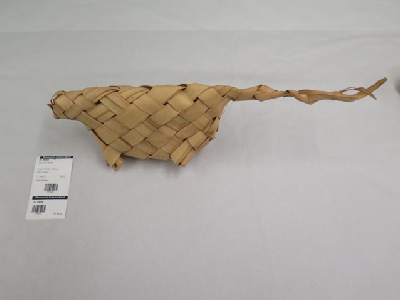Record metadata:
| Type | Cultural Object (2014 Definition) |
|---|---|
| Title | IIc 6569 |
| Keywords | Woven fibre animal-shape |
| Description | People stored salt grains, asi boku, M inside this woven form that is reminiscent of a rat (laho, T). Salt was traded from Laga on the north coast to Baguia. Various shapes of ero can be woven for salt storage or for use as katupas, in which rice is boiled. the rice is then served as a portion in the katupas. Other forms of ero include buffalo heart (kerau fuan, T) and star (ifi bere, ?). |
| Creator of Object | Presumed Makasae people |
| Date Created | Pre August 1935 |
| Place Created | Presumed Baguia Sub-district, Baucau District, Timor-Leste |
| Object Type | Basket |
| Dimensions | 42 cm length 10 cm width 11.6 cm height |
| Use status in 2014 | Still used |
| Material | Palm fronds, akadiru, T (Borassus flabellier, L.) |
| Technique | Hand woven |
| Institution/Holder: object | Museum der Kulturen Basel |
| Collector | Dr Alfred Bühler |
| Date Collected | August 1935 |
| Place Collected | Baguia Sub-district, Baucau District, Timor-Leste |
| File Copyright | Museum der Kulturen Basel. Photograph taken by Joanna Barrkman, 2014 |
| MKB/Buehler object title | Behältnis, G [container] ero ero, M |
| Notes | Viewed and identified at community viewings at Alawa Kraik 5/8/14 and Larisula 16/8/14. Also identified by Sra Ana Maria Pinto, Nelu Dae, Alawa Kraik on 6/8/14 and Sra Joanna Fernandes, Bahatata, on 10/8/2014. |
| Production status in 2014 | Still made |
| Timorese Language Term/s | Ero, tabi-tabi, M Katupa ba masin fatuk, T |
Linked Files:
IIc6569.jpg

(C)IIc6569.jpg
IIc6569.jpg&fileId=20867)